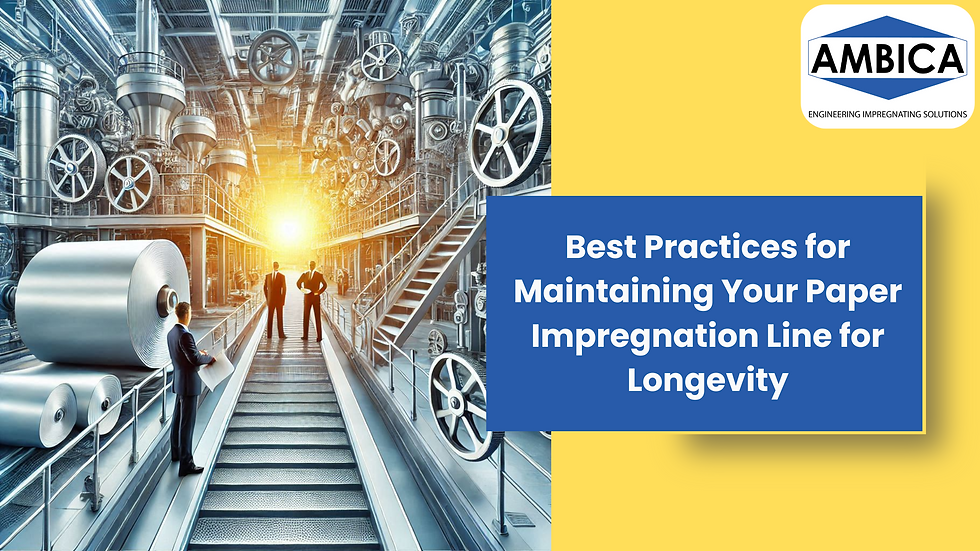Paper Impregnation Techniques: Boosting Performance and Versatility
- Ambica Impreg

- Nov 12, 2024
- 4 min read
Updated: Nov 25, 2024

The process of paper impregnation has become a crucial technique in various industries where enhanced performance and durability are required. Whether for decorative laminates, insulation, or industrial applications, paper impregnation plays a pivotal role in improving the functionality of paper products. In this comprehensive guide, we explore the techniques behind paper impregnation, its benefits, and how advanced paper impregnation plant are revolutionizing this industry.
What is Impregnation of Papers?
Papers Being Impregnated is the process of treating paper with specialized resins, chemicals, or other substances to enhance its physical and mechanical properties. This process results in paper that is more resistant to moisture, heat, chemicals, and mechanical wear. The impregnated paper can be used for diverse applications, including laminates, filter media, insulation materials, and packaging solutions.
By embedding resins into the paper fibers, the structural integrity of the paper is improved, making it more durable and suitable for demanding applications. The choice of resin and impregnation technique largely depends on the intended use of the final product. For instance, melamine resins are often used for decorative laminates, while phenolic resins are preferred for industrial-grade applications.
Key Benefits of Papers Being Impregnated
Enhanced Durability: One of the most significant advantages of
Impregnation of Papers is its ability to extend the life of paper-based products. By reinforcing the paper fibers with resins, the resulting material can withstand harsh environments and heavy usage.
Improved Moisture Resistance: Impregnated paper exhibits superior resistance to moisture, which is essential for applications like kitchen countertops, flooring, and outdoor furniture. This moisture barrier helps prevent warping, swelling, or degradation over time.
Chemical Resistance: The impregnation process can significantly increase the paper's resistance to chemicals, making it suitable for industrial settings where exposure to harsh substances is common.
Thermal Stability: Impregnated paper can endure high temperatures, making it ideal for electrical insulation and other heat-sensitive applications.
Versatility in Applications: From decorative laminates to industrial filters, the versatility of impregnated paper opens up endless possibilities for its use across various sectors.
The Role of Equipment for Papers Being Impregnated
The efficiency and quality of the Documents Under Impregnation process heavily rely on the technology used. Modern paper impregnation machines are designed to handle high volumes while ensuring uniform resin distribution and optimal drying. These machines are equipped with advanced features like precision control systems, automated resin application, and high-speed drying units.
Precision and Consistency: Equipment for Papers Being Impregnated ensure that the resin is evenly distributed across the paper, resulting in consistent quality throughout the production batch. This precision is crucial for achieving the desired performance characteristics of the impregnated paper.
High-Speed Production: With automation and advanced drying techniques, Equipment for Documents Under Impregnation can process large quantities of paper in a shorter time. This speed is essential for meeting the demands of high-volume production facilities.
Energy Efficiency: Modern machines are designed to minimize energy consumption, which not only reduces operational costs but also aligns with sustainable production practices. The integration of energy-efficient drying systems helps in reducing the carbon footprint of Impregnation of Papers plants.
Setting Up a Plant for the Impregnation of Paper
Establishing a A plant used to impregnate paper involves a careful consideration of various factors, including machinery, raw materials, production capacity, and environmental regulations. Here's a closer look at the essential components of a successful Documents Under Impregnation plant setup:
Selection of the Right Paper Impregnation Machine: The choice of machinery is critical to the efficiency and scalability of the impregnation process. Machines that offer customizable settings for different types of resins and paper grades provide greater flexibility.
Raw Material Sourcing: The quality of the base paper and resin significantly impacts the performance of the impregnated product. Therefore, sourcing high-quality materials is essential for achieving superior results.
Production Line Design: An optimized production line ensures smooth workflow, minimizes waste, and reduces downtime. The layout should be designed to accommodate the flow of paper from resin application to drying and curing.
Quality Control Systems: Implementing robust quality control measures is crucial for maintaining product consistency. Advanced sensors and monitoring tools integrated into the impregnation machines can detect any deviations in resin application or paper quality.
Environmental Considerations: Adhering to environmental regulations is a must for A plant that is used to make paper. The use of eco-friendly resins and energy-efficient machines can help reduce the environmental impact of the manufacturing process.
Applications of Impregnated Paper
The versatility of impregnated paper allows it to be used in various applications, each requiring specific performance characteristics:
Decorative Laminates: Impregnated paper is widely used in the production of high-pressure laminates for furniture, flooring, and countertops. The decorative surface layer, impregnated with melamine resin, offers an attractive finish and excellent durability.
Electrical Insulation: For electrical and electronic components, impregnated paper serves as an insulating material due to its thermal stability and dielectric properties.
Industrial Filters: Impregnated filter papers are designed to withstand harsh environments, making them ideal for automotive, hydraulic, and chemical filtration.
Packaging Materials: The moisture-resistant properties of impregnated paper are beneficial in packaging applications where protection against humidity is crucial.
Conclusion
Documents Under Impregnation is a game-changer in enhancing the performance and versatility of paper-based products. With the right techniques, equipment, and materials, manufacturers can produce high-quality impregnated paper that meets the demands of various industries. Investing in advanced Equipment for Papers Being Impregnated and setting up an efficient paper impregnation plant can significantly boost production capabilities while maintaining top-notch quality.



